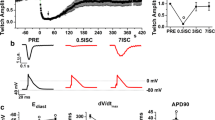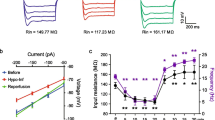Abstract.
During prolonged depolarization of excitable cells, some voltage-activated, tetrodotoxin-sensitive sodium channels are resistant to inactivation and can continue to open for long periods of time, generating a "persistent" sodium current (I NaP). The amplitude of I NaP is small [generally less than 1% of the peak amplitude of the transient sodium current (I NaT)], activates at potentials close to the resting membrane potential, and is more sensitive to Na channel blocking drugs than I NaT. It is thought that persistent Na channels are generated by a change in gating of transient Na channels, possibly because of a change in phosphorylation or protein structure, e.g. loss of the inactivation gate. Drugs that block Na channels can prevent the increase in [Ca2+]i in cardiac cells during hypoxia. Hypoxia increases the amplitude of I NaP. Paradoxically, NO causes a similar increase in I NaP and the effects of both can be inhibited by reducing agents such as dithiothreitol and reduced glutathione. It is proposed that an increased inflow of Na+ during hypoxia increases [Na+]i, which in turn reverses the Na/Ca exchanger so that [Ca2+]i rises. An increase in I NaP and [Ca2+]i could cause arrhythmias and irreversible cell damage.
Similar content being viewed by others
Author information
Authors and Affiliations
Additional information
Electronic Publication
Rights and permissions
About this article
Cite this article
Hammarström, A.K., Gage, P.W. Hypoxia and persistent sodium current. Eur Biophys J 31, 323–330 (2002). https://doi.org/10.1007/s00249-002-0218-2
Received:
Revised:
Accepted:
Issue Date:
DOI: https://doi.org/10.1007/s00249-002-0218-2




